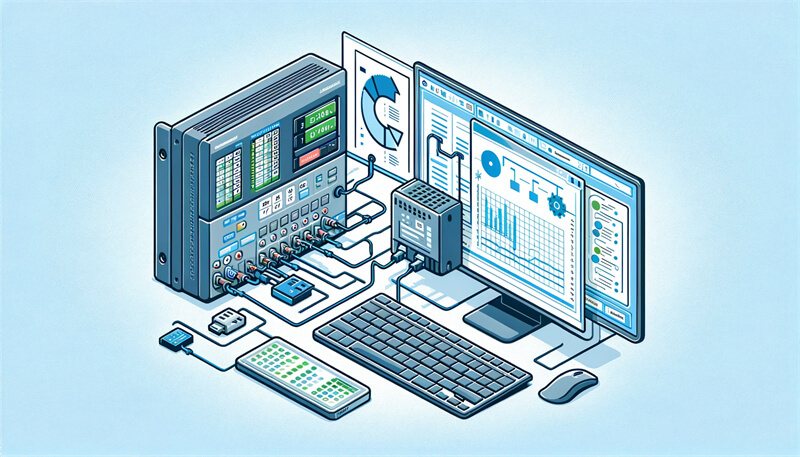Key Takeaways
| Question | Answer |
|---|---|
| What are the methods for exporting data? | Siemens WinCC, S7 Excel Connect, third-party tools like Kepware, XLReporter, and community solutions |
| Which Siemens PLC models are supported? | S7-1200, S7-300, S7-400, S7-1500 |
| What tools are recommended for this task? | WinCC, S7 Excel Connect, Kepware, XLReporter, Redlion DataStation Plus |
| What is the complexity level of each method? | Varies from simple Excel add-ins to advanced WinCC configurations |
| Are there any best practices to follow? | Ensure data accuracy, optimize logging intervals, manage large datasets effectively |
Introduction
In the world of industrial automation, Siemens PLCs are a cornerstone. These powerful devices control complex processes, ensuring efficiency and reliability. However, to make the most out of your Siemens PLC, exporting data to Excel for analysis is crucial. This guide will walk you through various methods to achieve this, ensuring you can harness the full potential of your PLC data.
Understanding Siemens PLC and Excel Integration
Siemens PLCs, such as the S7-1200, S7-300, and S7-1500, are designed to manage industrial processes with precision. However, analyzing this data in a user-friendly format like Excel can significantly enhance your decision-making processes. Excel provides a versatile platform for data analysis, reporting, and visualization, making it a perfect partner for Siemens PLCs.
Methods for Exporting Data from Siemens PLC to Excel
Using Siemens WinCC
WinCC is a powerful tool that allows for comprehensive data management and visualization. Here’s how you can export data using WinCC:
- Cyclic Export: Configure cyclic exports in WinCC to automatically transfer data to a CSV file. This method ensures data is regularly updated and accessible.
- OLE DB Provider: Use the OLE DB Provider for more advanced data manipulation and integration with Excel.
- Online Trend Control: Export data directly from WinCC’s trend controls to Excel, providing real-time data analysis capabilities.
Example: To export temperature and voltage data every 10 minutes:
- Open WinCC and navigate to your project.
- Configure cyclic data exports or use the trend controls.
- Set the export interval and target file format (CSV).
- Verify the exported data in Excel.
Utilizing S7 Excel Connect
S7 Excel Connect is a practical tool that simplifies the process of reading data from Siemens PLCs into Excel. Follow these steps to set it up:
- Enable PUT/GET Communication: In TIA Portal, enable the “Permit access with PUT/GET communication” option for your PLC.
- Configure Connection Parameters: Open the Device Configuration to set the PLC’s IP address, rack, and slot numbers.
- Read Datablocks: Use S7 Excel Connect to read data from specific datablocks.
- Export to Excel: Configure the add-in in Excel to read and display the data.
Example: Reading data from a datablock in an S7-1200 PLC:
- Open TIA Portal and enable PUT/GET access.
- Set the IP address and other connection parameters.
- In Excel, use S7 Excel Connect to read data from the specified datablock.
- View and analyze the data directly in Excel.
Alternative Methods and Tools
Community-Recommended Solutions
Forums like MrPLC offer practical, community-driven solutions. Here are a few recommended tools:
- Kepware: A robust OPC server that facilitates data logging from PLCs to Excel.
- XLReporter: A specialized tool for generating reports from PLC data.
- Redlion DataStation Plus: A versatile device for data logging and communication.
Example: Logging VFD speed every 10 seconds with a timestamp:
- Use Kepware to set up an OPC connection to your Siemens PLC.
- Configure XLReporter to log data at the desired interval.
- Alternatively, use Redlion DataStation Plus for a more hardware-centric solution.
Third-Party Software Tools
Several third-party software tools provide excellent solutions for exporting Siemens PLC data to Excel. Automation Networks and SyTech are notable examples:
- Automation Networks: Offers products that integrate industrial automation with IT solutions, providing seamless data export capabilities.
- SyTech XLReporter: Specializes in creating detailed reports from PLC data, offering a range of features tailored for Siemens PLCs.
Example: Using XLReporter:
- Install and configure the software according to your PLC model.
- Set up data logging intervals and export formats.
- Generate detailed reports and visualize the data in Excel.
Best Practices for Data Logging and Export
Exporting data from Siemens PLC to Excel can be straightforward, but following best practices ensures data accuracy and efficiency. Here are some tips to optimize your data logging and export process:
Ensure Data Accuracy and Integrity
- Validate Data: Regularly check the data for any inconsistencies or errors.
- Time Stamping: Include timestamps with each data point to track changes and events accurately.
- Data Types: Ensure the correct data types are used to prevent errors in data interpretation.
Optimize Logging Intervals
- Set Appropriate Intervals: Choose logging intervals that match your data needs without overloading the system. For instance, log critical data more frequently while less critical data can be logged less often.
- Storage Management: Manage storage by archiving old data and using efficient file formats like CSV to save space.
Manage Large Datasets in Excel
- Use Excel Features: Utilize Excel’s features like pivot tables, filters, and charts to manage and analyze large datasets effectively.
- Automate Tasks: Use Excel macros or add-ins to automate repetitive tasks, such as data import and formatting.
Expert Advice and Community Tips
Gleaning insights from experts and community forums can provide practical tips and solutions that are tried and tested. Here are some pieces of advice from industry experts and community members:
Insights from Siemens Experts
- Follow Official Documentation: Siemens provides comprehensive guides and official documentation for their products. Always refer to these resources for accurate and detailed instructions.
- Use Siemens Tools: Tools like WinCC and S7 Excel Connect are designed to work seamlessly with Siemens PLCs, offering robust and reliable data export capabilities.
Practical Advice from Community Forums
- Explore Multiple Solutions: Community forums like MrPLC offer various solutions and tool recommendations based on real-world experiences. Tools like Kepware and Redlion DataStation Plus are often recommended for their ease of use and reliability.
- Customize Solutions: Adapt solutions based on your specific requirements. Community members often share customized scripts and configurations that can be tailored to your needs.
Common Challenges and Troubleshooting Tips
- Connection Issues: Ensure that the PLC and the computer are on the same network and that the correct IP addresses and ports are configured.
- Data Overload: Manage the amount of data being exported to avoid overloading Excel. Use filtering and selective data export to handle large datasets efficiently.
- Software Compatibility: Ensure that the software versions of the PLC, WinCC, and Excel add-ins are compatible.
Conclusion
Exporting data from Siemens PLC to Excel opens up a world of possibilities for data analysis and decision-making. Whether you choose the robust features of WinCC, the simplicity of S7 Excel Connect, or third-party tools, following the outlined methods and best practices will help you achieve seamless data integration.
At ControlNexus, we are dedicated to providing top-quality Siemens PLCs, HMIs, and Inverters. Our expertise and extensive product range, established in 2013, make us a reliable partner for all your industrial automation needs. For more information and support, visit our website or contact us.
FAQs
What are the main methods for exporting data from Siemens PLC to Excel?
The main methods include using Siemens WinCC, S7 Excel Connect, and third-party tools like Kepware and XLReporter.
Can I export data from any Siemens PLC model?
Yes, commonly used models such as S7-1200, S7-300, S7-400, and S7-1500 support data export to Excel.
What are the best practices for ensuring data accuracy?
Ensure data validation, include timestamps, use correct data types, and regularly check for inconsistencies.
How can I manage large datasets in Excel?
Utilize Excel features like pivot tables, filters, and charts, and automate repetitive tasks using macros or add-ins.
Where can I find more resources and support?
For more resources, expert advice, and support, visit the ControlNexus website or contact us.
For further insights and product information, explore our extensive range of Siemens automation products on our product page.
By following these guidelines, you can efficiently manage and analyze your Siemens PLC data, driving better decision-making and operational efficiency in your industrial processes.



